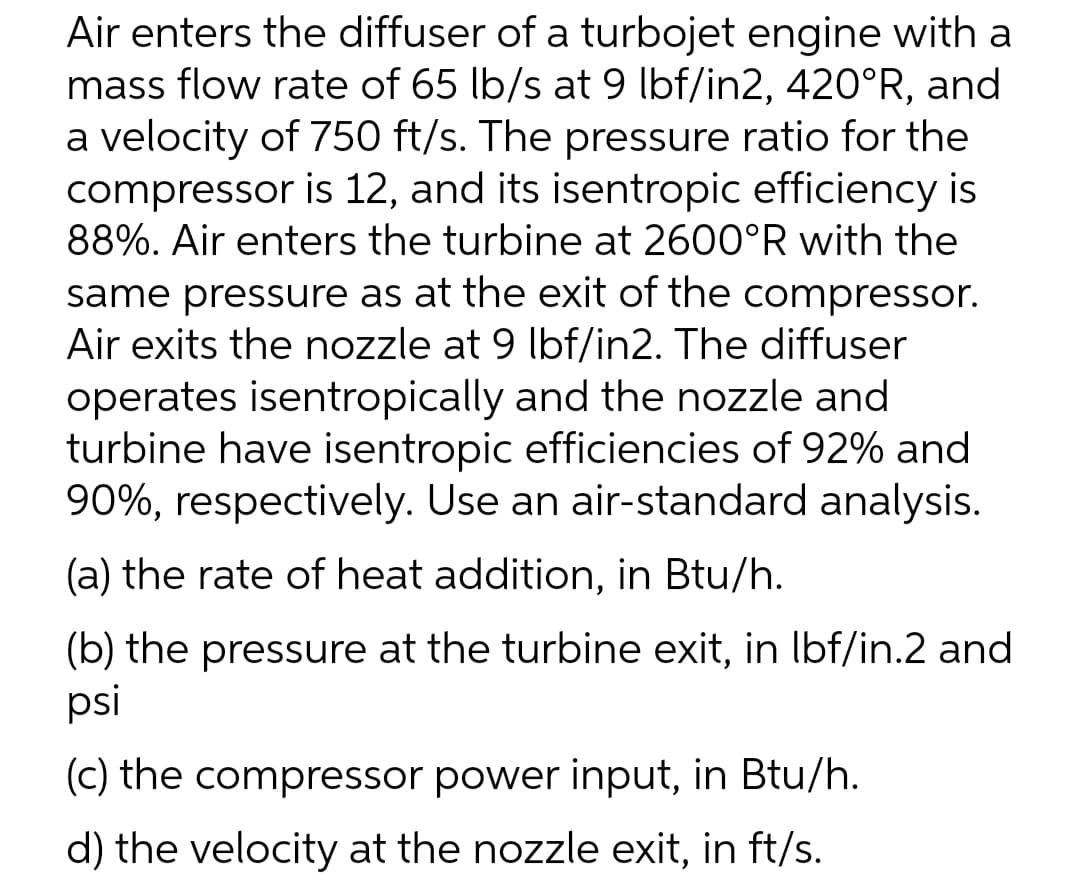Air enters the diffuser of a turbojet engine with a mass flow rate of 65 lb/s at 9 lbf/in2, 420°R, and a velocity of 750 ft/s. The pressure ratio for the compressor is 12, and its isentropic efficiency is 88%. Air enters the turbine at 2600°R with the same pressure as at the exit of the compressor. Air exits the nozzle at 9 lbf/in2. The diffuser operates isentropically and the nozzle and turbine have isentropic efficiencies of 92% and 90%, respectively. Use an air-standard analysis. (a) the rate of heat addition, in Btu/h. (b) the pressure at the turbine exit, in Ibf/in.2 and psi (c) the compressor power input, in Btu/h. d) the velocity at the nozzle exit, in ft/s.
Air enters the diffuser of a turbojet engine with a mass flow rate of 65 lb/s at 9 lbf/in2, 420°R, and a velocity of 750 ft/s. The pressure ratio for the compressor is 12, and its isentropic efficiency is 88%. Air enters the turbine at 2600°R with the same pressure as at the exit of the compressor. Air exits the nozzle at 9 lbf/in2. The diffuser operates isentropically and the nozzle and turbine have isentropic efficiencies of 92% and 90%, respectively. Use an air-standard analysis. (a) the rate of heat addition, in Btu/h. (b) the pressure at the turbine exit, in Ibf/in.2 and psi (c) the compressor power input, in Btu/h. d) the velocity at the nozzle exit, in ft/s.
Elements Of Electromagnetics
7th Edition
ISBN:9780190698614
Author:Sadiku, Matthew N. O.
Publisher:Sadiku, Matthew N. O.
ChapterMA: Math Assessment
Section: Chapter Questions
Problem 1.1MA
Related questions
Question

Transcribed Image Text:Air enters the diffuser of a turbojet engine with a
mass flow rate of 65 lb/s at 9 lbf/in2, 420°R, and
a velocity of 750 ft/s. The pressure ratio for the
compressor is 12, and its isentropic efficiency is
88%. Air enters the turbine at 2600°R with the
same pressure as at the exit of the compressor.
Air exits the nozzle at 9 lbf/in2. The diffuser
operates isentropically and the nozzle and
turbine have isentropic efficiencies of 92% and
90%, respectively. Use an air-standard analysis.
(a) the rate of heat addition, in Btu/h.
(b) the pressure at the turbine exit, in lbf/in.2 and
psi
(c) the compressor power input, in Btu/h.
d) the velocity at the nozzle exit, in ft/s.
Expert Solution
This question has been solved!
Explore an expertly crafted, step-by-step solution for a thorough understanding of key concepts.
This is a popular solution!
Trending now
This is a popular solution!
Step by step
Solved in 5 steps with 1 images

Knowledge Booster
Learn more about
Need a deep-dive on the concept behind this application? Look no further. Learn more about this topic, mechanical-engineering and related others by exploring similar questions and additional content below.Recommended textbooks for you

Elements Of Electromagnetics
Mechanical Engineering
ISBN:
9780190698614
Author:
Sadiku, Matthew N. O.
Publisher:
Oxford University Press

Mechanics of Materials (10th Edition)
Mechanical Engineering
ISBN:
9780134319650
Author:
Russell C. Hibbeler
Publisher:
PEARSON

Thermodynamics: An Engineering Approach
Mechanical Engineering
ISBN:
9781259822674
Author:
Yunus A. Cengel Dr., Michael A. Boles
Publisher:
McGraw-Hill Education

Elements Of Electromagnetics
Mechanical Engineering
ISBN:
9780190698614
Author:
Sadiku, Matthew N. O.
Publisher:
Oxford University Press

Mechanics of Materials (10th Edition)
Mechanical Engineering
ISBN:
9780134319650
Author:
Russell C. Hibbeler
Publisher:
PEARSON

Thermodynamics: An Engineering Approach
Mechanical Engineering
ISBN:
9781259822674
Author:
Yunus A. Cengel Dr., Michael A. Boles
Publisher:
McGraw-Hill Education

Control Systems Engineering
Mechanical Engineering
ISBN:
9781118170519
Author:
Norman S. Nise
Publisher:
WILEY

Mechanics of Materials (MindTap Course List)
Mechanical Engineering
ISBN:
9781337093347
Author:
Barry J. Goodno, James M. Gere
Publisher:
Cengage Learning

Engineering Mechanics: Statics
Mechanical Engineering
ISBN:
9781118807330
Author:
James L. Meriam, L. G. Kraige, J. N. Bolton
Publisher:
WILEY